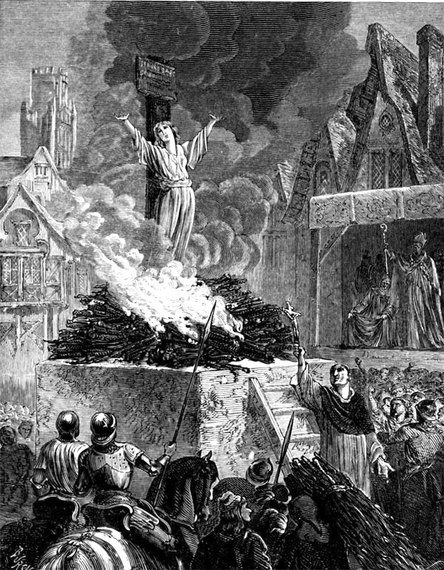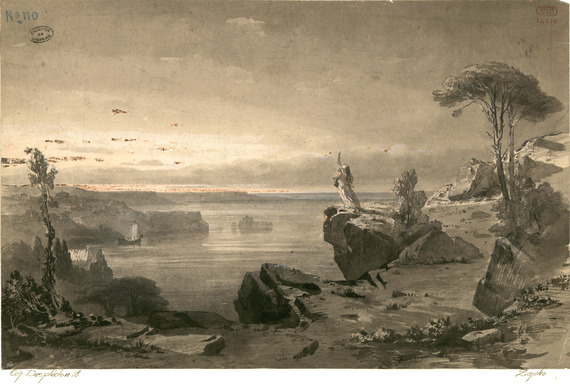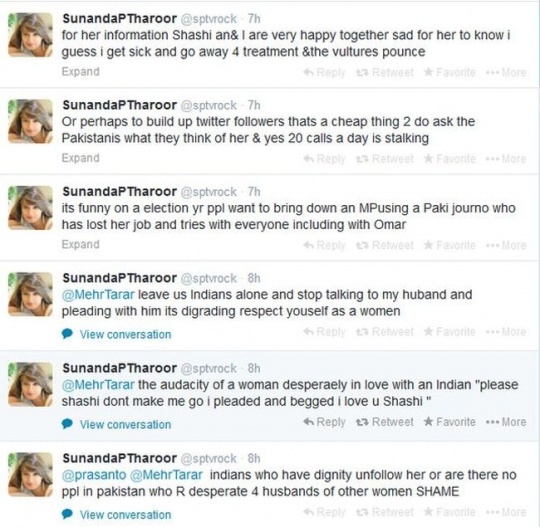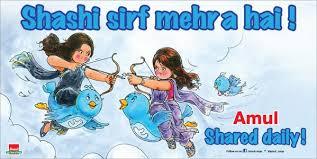When I first read of the Myth of Sappho, I was reasonably troubled that a famed Greek poetess would jump off the Leucadian cliffs for love of Phaon, a deeply flawed man. Why would a woman like Sappho kill herself over unrequited love? Did she not realise that she was better than the love of a loathsome man, inferior to her ? Rationality dictates that no life is worth giving up for another. Or like others have said it repeatedly today, "No man is ever worth it.." But who amongst us, has had rationality rule our actions when faced with the great loves, passions, madness and betrayals of our life?
But the prudent pragmatist in me would beg another version, a rethinking. It was not unrequited love that made Sappho's leap, a mainstay of our myth, it was something else. It was a comforting misogynistic tale attached as an epilogue, a few hundred years after her death. First it suggested that a "woman" who had dared to trespass, and be different had to be mad all along. Second, the subversives always had to be reclaimed. Political rebels, internal subversives and non ideal type had to be tamed or done away with.
Elizabeth Taylor as Katherine in Taming of the Shrew
In Shakespeare's Taming of the Shrew, a man "acquires" a rich but headstrong woman as his bride. Minus the comedic sub-plots and slapstick comedy the bare bones of the story is "notoriously aggressive" Katherine and her "tamer" husband Petruchio. But Katherine is neither aggressive nor notorious, she wears her indescribable naivety and sheer straightforwardness with an innocent integrity of a woman who is comfortable in her skin. This irritates people.
Later Petruchio drags Kate away from her own wedding reception, insisting she is his "chattels" , when he deprives her of food and sleep until she learns to bend her will to his entirely, it is hard not to squirm in discomfort, even if we know Petruchio to be a vindictive caricature. Some have argued that Katherine subverts the patriarchy by acting like a submissive wife, manipulating Petruchio, she simply acts like someone else. Whatever interpretation you choose to favor, one fact remains, that the women had to be tamed, she had to manifestly re-fashion her self to comply with the new set of realities. To win she had to transform herself into something else, someone she is not.
Feminism and hard won victories of it are not that women have equal opportunities and better pay, it is that we must make it possible for them to be who they are, their right to choose, without being pigeon holed into archetypes. It is Sappho's right to be a poetess in a largely male dominated creative world; her love for women, her sexual desires and her acts of political subversion can all exist without her story being rewritten with death for an unrequited hetrosexual love.
Curious Case of Sunanda Pushkar
Sunanda Pushkar, burst into the imagination of the Indian nation through a tweet relating to IPL equity in 2010. She was the other woman, the consort of the reigning Minister, quickly the scandalous vamp and a gold digger. Hate, misogyny and acerbic vitriol underscored most reporting about her. Her "insatiable ambition", "Louis Vuitton victimhood", her clothes, her make up and her "peroxide blonde" highlights all became the symbols of a woman who just did not resonate with our ideal type. It was not just men, but women chimed in to create vindictive narratives, often dismissing her as a "wannabe". Hélène Cixous in her essay, "The Laugh of the Medusa" asserts that , "Woman must write herself: must write about (other) women and bring women to writing, from which they have been driven away as violently as from their bodies."
Yet it was Vrinda Gopinaths account "Got A Girl, Named Sue And she knew just what to do. Sunanda's eye-popping life-story", considered the most acerbic of all salacious accounts that made Sunanda Pushkar "body" the center of piece. The article carried the following statements:
"Their lives would have soon settled into a mundane routine if it were not for Sunanda's hyper hunger to rise above the plain folks."
"...but stunned her colleagues with her insatiable ambition."
"Her skills in occasionally getting well-known sponsors made her rivals green with envy but the snide bitching barely fazed her. Says a former rival acidly, 'Sunanda would claw her way to a sponsor and have him eating out of her hands, she was not a girl's girl.'"
" Sunanda was the p3p Queen of Masala Dubai, chasing the glittering mirage with vampire-like thirst--"
"Dubai flash trash of peroxide hair streaks, heavy make-up, razzle-dazzle, seductive couture, false eyelashes, chrome nail paint, and Louis Vuitton victimhood. It was a sign of her arrival in the league of the neo-rich tycoons."
In an interview with Tehelka, Sunanda Pushkar tried to reclaim her story. She spoke of early mistakes in life and love, about loss, doing odd jobs, becoming an entrepreneur, putting her brother through college, being a single mother and raising a son against all odds. If we did not know what Sunanda Pushkar looked like, we would have easily seen her as a modern day Nargis of the famed Mother India. But she wasn't. She did not fit our idealisation of a middle aged women. She was confident, brazzy and hot. Then she became Mrs. Tharoor and the world was still unkind. We had bestowed upon her the archetypal "vamp" title, but vamps don't become wives.
Like Katherine from Taming of the Shrew, Sunanda Pushkar was an unlikely figure who spoke her mind with a certain unbelievable naivety . Unlike other political wives who took the back seat, she was visible. She publicly commented on Article 370. Later making another candid remark, that she had to choose between being a wife or a Kashmiri.
When the question of Mr and Mrs Tharoor came up, journalist across the board had similar reactions in private, they always smirked and it was followed by comments about the "old dog getting some", or about Mrs. Tharoor's haute couture choices. Her cleavage and insatiable ambition got more talk time than the person she was.
Then the saga of the alleged extramarital affair emerged only to make things worse. Mrs Tharoor and Ms. Mehr Tarar both took pot shots at each other, and became engulfed in an avalanche of diatribe.
Mr. Tharoor made a clinical statement and was at best chided for having a penchant for controversy and being a ladies man. But the women in this saga became the irrationally jilted and the mad depressed wife; the whore and the femme fatale ISI agent seducing an unwitting man. We reduced them to madness induced maidens fighting over a man, manipulative vixens and much much more. Even nationally famous Amul's cartoon depicted two grown, accomplished women fighting over a man like a bunch of hormonal teeanagers. It is still the original sin of eve, that led to the fall of man.
Well witches are always women...
 The Devil in the Shape of a Woman by Carol Karlsen studied witchcraft trials from both Europe and New England. Vast majority of the accused and executed were women and most often women over forty, past their childbearing and childrearing years. Those women were particularly the ones who did not fit into the typical framework of a good, obedient wife, the one who is supposed to help reinforce the male-dominated hierarchical structure of the society. Karlsen maintains that the accused and executed women were predominantly held in higher esteem in the society, the ones who by exhibiting non-conformist views and employing independent judgment endangered male hegemony, often vilified by other women.
The Devil in the Shape of a Woman by Carol Karlsen studied witchcraft trials from both Europe and New England. Vast majority of the accused and executed were women and most often women over forty, past their childbearing and childrearing years. Those women were particularly the ones who did not fit into the typical framework of a good, obedient wife, the one who is supposed to help reinforce the male-dominated hierarchical structure of the society. Karlsen maintains that the accused and executed women were predominantly held in higher esteem in the society, the ones who by exhibiting non-conformist views and employing independent judgment endangered male hegemony, often vilified by other women.
Bounded submersion was one of the many tests instituted to confirm witchcraft allegations against these women. The accused women had their hands and legs bound, a heavy rock was attached to their body and they were cast into the water. If the body floated to the surface the accused was indeed a witch. If she drowned she was innocent. The accused were sentenced to death, much before an actual determination of guilt. How little have we changed?
The witch hunt that tore down Sunanda Pushkar, is now focused on Mehr Tarar. The Twittersphere is full of hateful vengeance against her, populous in both countries succumbing to garden-variety pettiness, vindictiveness, hate and hysteria. Men and women have joined in to call her a whore and a home wrecker. Ms. Tarar herself went on record in an interview saying that she was "only a housewife, a soccer mom," how indeed could she be the philandering vamp she is made out to be, because we all know that a "good wife" can never be the vamp. Mehr Tarar, the journalist is gone. She will forever be infamous for her alleged dalliances. Just as "Mrs. Tharoor" become the infamous Sue, for her clinging saree's and peroxide blonde hair.
Hélène Cixous said, "There is no greater love than the love the wolf feels for the lamb-it-doesn't-eat." Now the love is lost and the daggers are being drawn for another slaughter.
What's love got to do with it ?





